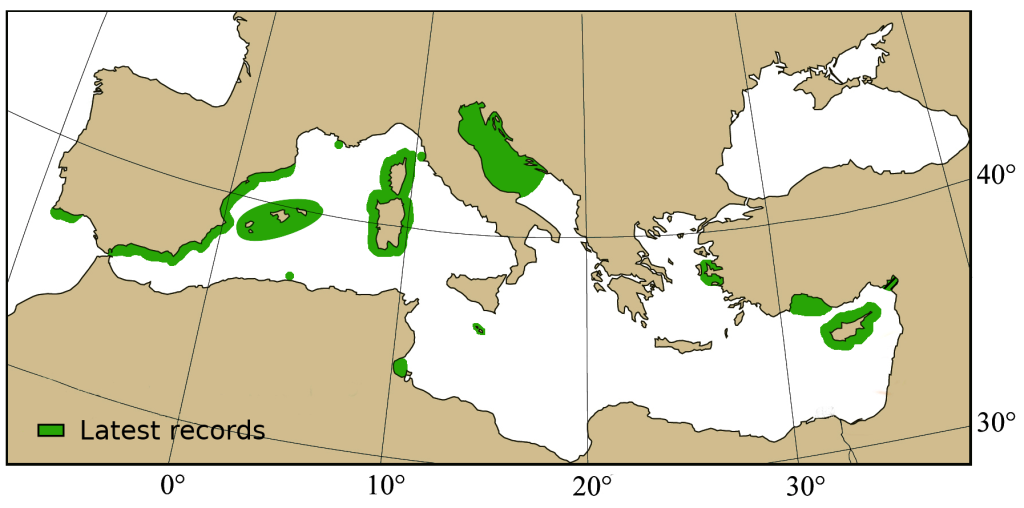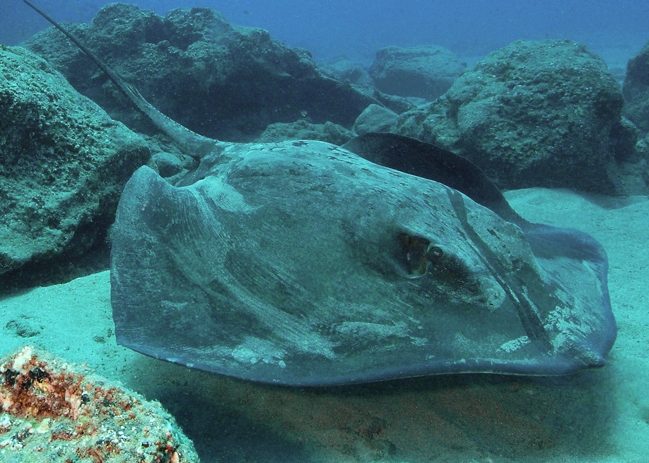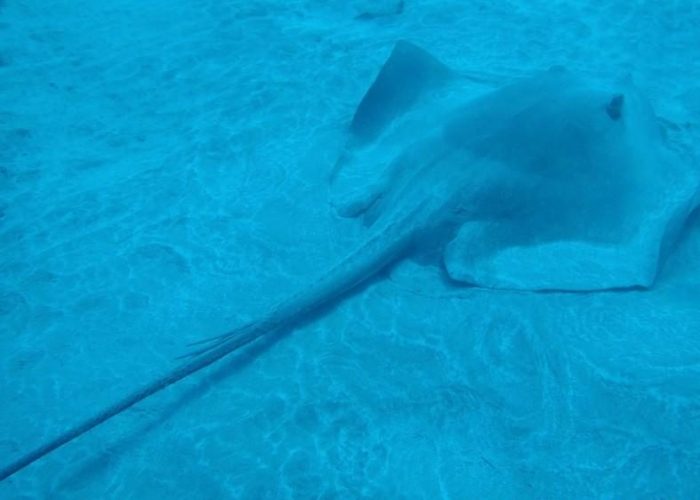Bathytoshia lata
Common name: Brown Stingray, Roughtail Stingray
Order: Myliobatiformes
Family: Dasyatidae
Synonyms: Dasyatis lata, Trygon lata
Misidentifications: Bathytoshia centroura
Short description
Very large species. Broad and rhombic disc with pectoral fin apex narrowly angular. Very thick trunk. Sharp thorns over its disc and tail in adults. Skin is smooth with large tubercles or buckles on the dorsal midline of adults. Short snout, broadly triangular. Small eyes and protruding slightly. Broad tail, depressed at the base (length twice the width of the disc).
Color: Olive brown dorsal surface or plain grayish brown or black. All surfaces are black beyond sting. Ventral surface entirely white, black ventral fold. Usually with irregular flecks where skin is damaged on the disc.
Measurements:
- Disk width (DW): 100-130 cm (max 260 cm)
- Total length (TL): to 396 cm
- Weight: to 350 kg
Swimming pattern: Undulatory locomotion.
Biology / Ecology
Feeds on crabs, prawns and small fishes.
Max age: 28 years.
Reproduction: Viviparous (aplacental viviparity). Size at maturity (DW): 100 cm male, 110 cm female. Age at maturity: 15 years. Gestation period: ~4 months. Juveniles per litter: 2-6 produced in autumn and early winter. Size at birth (DW): 34-37 cm.
Habitat: Demersal or benthic on insular and continental shelves. Found on sandy or muddy bottoms, sometimes near coral reefs from shallow waters to 200 m (max 800 m deep).
Previously considered in the Mediterranean Sea as Bathytoshia centroura. Current geographic distribution of both species needs to be clarified.
Distinguishing characteristics
- Relatively narrow fold under the tail.
- Large nodules on the dorsal surface.
Myliobatiformes: No caudal and anal fin. Thin tail like a whip.
Dasyatidae: Batoids with depressed bodies.
Distribution
Due to the recent change of the taxonomy of this species, many records are old and require verification.
Worldwide: Northwestern Atlantic from Cape Cod to Gulf of Mexico. Southwestern Atlantic from Brazil to Argentina. Eastern Atlantic from Bay of Biscay to Angola, including the Mediterranean Sea.
Mediterranean:
- Occurrence: Rare and occasional in the Eastern Mediterranean Sea.
- Latest records: Malta (2023), Cyprus (2018-2022), Portugal (1986-2017), Izmir – Turkey (2016), Island of Glavat – Croatia (2017), Adriatic Sea (2015), Corse (2015), Sardinia (2015), Spain and Balearic Sea (2015), Iskenderun Bay – Turkey (2014), Gulf of Antalya – Turkey (2010), Tunisia (2001).

Any recent observation not on the map?
Contact us!
Conservation
Threats: Bycatch in artisanal and industrial fisheries. Retained for human consumption for its meat, cartilage and thorny tail.
Protection level:
- Global: Vulnerable (IUCN 2021, last assessment: 2020)
Key references
- Agius A., Borg J. A., Schembri P. J. 2024. Batoid fishes associating with tuna farms in Malta. Rapp. Comm. int. Mer Médit. 43: 273.
- Akyol O., Aydın İ., Ulaş A., Capapé C. 2017. On the capture of a large pregnant Bathytoshia lata (Chondrichthyes: Myliobatiformes: Dasyatidae) from the coast of Çeşme, Izmir (Aegean Sea, Turkey). Journal of the Black Sea/Mediterranean Environment 23(1): 92-99.
- Başusta N., Sulikowski J.A. 2012. The oldest estimated age for roughtail stingray [Dasyatis centroura (Mitchill, 1815)] from the Mediterranean Sea. Journal of Applied Ichthyology 28(4): 641-642.
- Carpentieri P., Nastasi A., Sessa M., Srour A. 2021. Incidental catch of vulnerable species in Mediterranean and Black Sea fisheries – A review. General Fisheries Commission for the Mediterranean – Studies and Reviews 101: I-317.
- Dulčić J., Jardas I., Onofri V., Bolotin J. 2003. The roughtail stingray Dasyatis centroura (Pisces: Dasyatidae) and spiny butterfly ray Gymnura altavela (Pisces: Gymnuridae) from the southern Adriatic. Journal of the Marine Biological Association of the United Kingdom 83(4): 871-872.
- Ferretti F., Osio G.C., Jenkins C.J., Rosenberg A.A., Lotze H.K. 2013. Long-term change in a meso-predator community in response to prolonged and heterogeneous human impact. Scientific reports 3(1) : 1-11.
- Follesa M. C., Marongiu M. F., Zupa W., Bellodi A., Cau A., Cannas R., Colloca F., Djurovic M., Isajlovic I., Jadaud A., Manfredi C., Mulas A., Peristeraki P., Porcu C., Ramirez-Amaro S., Salmerón Jiménez F., Serena F., Sion L., Thasitis I., Cau A., Carbonara P. 2019. Spatial variability of Chondrichthyes in the northern Mediterranean. Scientia Marina 83(S1): 81-100.
- Giovos I., Serena F., Katsada D., Anastasiadis A., Barash A., Charilaou C., Hall-Spencer J.M.,Crocetta F.,Kaminas A., Kletou D, Maximiadi M., Minasidis V., Moutopoulos D.K., Aga-Spyridopoulou R.N., Thasitis I., Kleitou P. 2021. Integrating literature, biodiversity databases, and citizen-science to reconstruct the checklist of Chondrichthyans in Cyprus (Eastern Mediterranean Sea). Fishes 6(3): 24.
- Guijarro B., Quetglas A., Moranta J., Ordines F., Valls M., González N., Massutí E. 2012. Inter- and intra-annual trends and status indicators of nektobenthic elasmobranchs off the Balearic Islands (northwestern Mediterranean). Scientia Marina 76: 87–96.
- O’Keefe M., Bengil EG., Palmer JL, Beton D, Çağlar Ç., Godley B.J, Özkan M., Snape R.T.E., Broderick A.C. 2023. Diversity and distribution of elasmobranchs in the coastal waters of Cyprus: using bycatch data to inform management and conservation. Front. Mar. Sci. 10: 1181437.
- Özbek E.Ö., Çardak M., Kebapçioğlu T. 2015. Spatio-temporal patterns of abundance, biomass and length-weight relationships of Dasyatis species (Pisces: Dasyatidae) in the Gulf of Antalya, Turkey (Levantine Sea). Journal of Black Sea/Mediterranean Environment 21(2): 169-190.
- Ramírez-Amaro S., Ordines F., Esteban A., García C., Guijarro B., Salmerón F., Terrasa B., Massutí E. 2020. The diversity of recent trends for chondrichthyans in the Mediterranean reflects fishing exploitation and a potential evolutionary pressure towards early maturation. Scientific Reports 10(1): 1-18.
- Soldo A., Lipej L. 2022. An Annotated Checklist and the Conservation Status of Chondrichthyans in the Adriatic. Fishes 7(5): 245.



